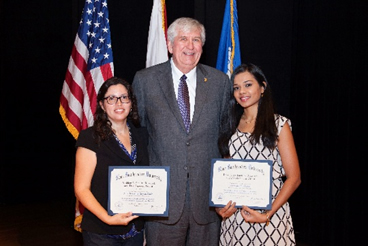Identification of Bacterial Type III Secretion System Inhibitors Produced by Soil Bacteria
Grant Winners
- Julie Torruellas Garcia, Ph.D. – Halmos College of Oceanography and Natural Sciences
- Poorandai Shivbaran – Halmos College of Oceanography and Natural Sciences
Dean
- Richard Dodge, Ph.D. – Halmos College of Oceanography and Natural Sciences
Abstract

Overuse of antibiotics has led to the emergence of “super bugs”, posing a threat to global health. Commonly used antibiotics are becoming less effective; therefore, the development of new antimicrobials that bacteria will not become resistant to is a necessity. One innovative strategy is to find antimicrobials that target virulence factors in bacteria instead of cell processes. This strategy will reduce the selective pressure on the bacteria to mutate since virulence factors are often times not needed for growth. Some pathogenic bacteria including E. coli, Salmonella, Shigella, Chlamydia and Yersinia species utilize a type III secretion system (T3SS), which are needle-like structures on their surface used to inject host cells with toxins in order to evade our immune system and cause infection. Blocking the T3SS inhibits their ability to cause infection. Therefore, the T3SS is an ideal target for novel antimicrobials. Recently, I developed a new method for testing compounds to determine if they inhibit the Y. pestis T3SS. This method uses a special growth medium called Magnesium Oxalate (MOX) agar which produces distinct growth characteristics based on the bacteria's ability or inability to secrete toxins. The goal of this research is to use this new method to identify soil bacteria that produce T3SS inhibitors. Most antibiotics we use today were originally isolated from soil microorganisms. The large number of bacteria in soil causes many species of bacteria to produce antimicrobials in order to compete with each other for nutrients and space. Some plant pathogens utilize T3SSs, therefore it is feasible to anticipate that some soil bacteria may produce antimicrobials to target the T3SS in order to compete with these bacteria. Soil bacteria will be isolated by serial dilution plating and each isolate will be patched onto MOX agar plates pre-inoculated with Y. pestis. After incubation, the areas around each soil isolate will be analyzed for the Y. pestis growth characteristics associated with blocked T3S. The soil bacteria that exhibit positive results will be identified using 16S rDNA sequencing. Results of these experiments can lead to the development of novel antimicrobial drugs.